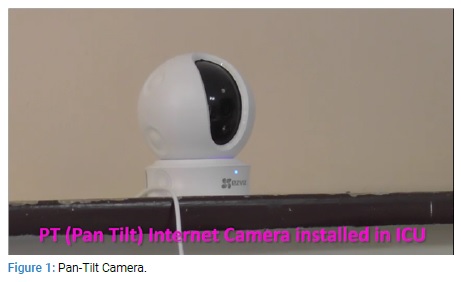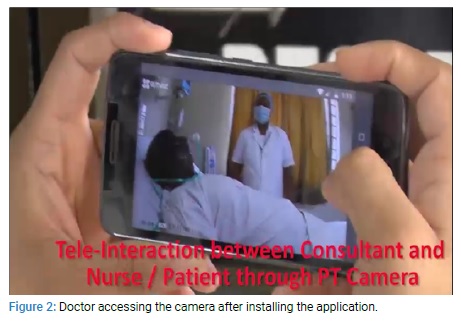Abstract
Telemedicine plays an important role in imparting healthcare facilities worldwide in special situations like the COVID-19 Crisis. Use of technology in healthcare has come a long way. Special cameras for surveillance and interaction have been used in fields of industries, offices, home based and national security systems etc. Here we describe our experience regarding the use of Pan-Tilt camera in Tele-interaction for imparting healthcare services during the time of Corona Pandemic.
Introduction
COVID-19 pandemic has been ravaging its influence and spreading all over the world in a rapid pace since its advent in December 2019 in Wuhan in China [1]. Lots of people all over the world have been affected including healthcare workers, many of whom have lost their life to the disease. Coronavirus disease is spread by droplet infection and risk of spread of the infection in a hospital setting from patient to healthcare worker, from healthcare worker to another healthcare worker is high, especially when there is lack of personal protective equipment to healthcare workers worldwide. Telemedicine and Tele-consultation has become an important aspect of healthcare worker patient interaction during Corona Pandemic. In this study we describe our experience regarding use of PT (Pan-Tilt) camera for live interaction between nurse and consultant in ICU.
Material and methods
This study was conducted in a tertiary care center in the department of plastic surgery during April-May 2020 at the time of COVID-19 pandemic after the departmental committee ethical approval. Informed consent was taken from the participants, both healthcare workers and the patients. Pan-Tilt camera was installed in intensive care units and smart phone devices were configured and application was downloaded. Once the device is set and camera installed, the treating doctor interacted with the patient and the ICU nurse regarding the patient problems and management, from a distant thus maintaining social distancing norms and unnecessary exposure to Coronavirus. (Figure 1 and 2).


The consultant interacted with patient and ICU nurse in real time and monitored the patient’s vital parameters and condition at that point of time through Tele-medicine. (Figure 3) Feedbacks were taken from the patient and the healthcare workers at the end of interaction. (Table 1).


The steps of setting up the camera is given in the quick start guide provided with the device, the salient steps include-
- Power On- Plug the power cable into the camera, and then plug the power adapter into an outlet.
- Camera setup- a) Create an user account- download and install EZVIZ app. b) Add camera to EZVIZ. c) Enable the Image Encryption. d) Angle Adjustment.
- SD Card Management.
- Mounting of the camera on wall or ceiling.
The details of each step with pictorial representation are provided with the user manual.
Results
At the end of the study it was found that both the patient and healthcare workers gave positive feedback regarding the use of PT camera for Tele-interaction. The application helped in maintaining social distancing and utilising telemedicine for patient care at the time of Corona Pandemic.
Discussion
COVID-19 (Coronavirus Disease-2019) pandemic is spreading rapidly worldwide since its advent in December 2019. Human Coronaviruses (HCoVs) represent a major group of Coronaviruses (CoVs) associated with multiple respiratory diseases of varying severity, including common cold, pneumonia and bronchiolitis [2]. Measures like maintaining social distancing, wearing masks, staying at home, avoiding social gatherings etc. have been implemented worldwide, many countries have declared lock-down for days allowing only emergency medical services and other essential services to function. Disease in healthcare workers is also on the rise owing to interaction with affected patients. Unnecessary hospital visits are being avoided. Patient monitoring and interaction has taken a new form owing to telemedicine services. Hospitals and healthcare workers are striving day by day to provide medical services to Corona as well as Non-Corona patients taking precautions to not spread the disease from patient to healthcare workers and vice-versa.
WHO defines telemedicine as “The delivery of health care services, where distance is a critical factor, by all health care professionals using information and communication technologies for the exchange of valid information for diagnosis, treatment and prevention of disease and injuries, research and evaluation, and for the continuing education of health care providers, all in the interests of advancing the health of individuals and their communities [3]. There are various telemedicine applications which can be classified into 4 basic types, according to the mode of communication (video, audio, text based, according to timing of information transmitted (Real time video/audio/text interaction), according to purpose of consultation (diagnosis, treatment, health education, counseling for non-emergency consultation and immediate assistance or first aid for emergency consultation)and according to individuals involved(doctor to patient, doctor to care giver, doctor to doctor, healthcare worker to doctor) [4].
Pan tilt camera facility with smart phone device application can be used for various telemedicine applications. It is easy to set-up, user friendly, can be accessed from anywhere and of utmost importance at time of pandemics such as Corona for maintaining practices of social distancing. The PT camera application is available freely in google play store/ Apple store for all smartphones. Multiple users can install it for Tele-monitoring and Tele-interaction.
PT camera can connect using any available Wi-Fi network or mobile data (3G/4G) network. Once PT camera is configured in a specific network, then tele-interaction is possible from anywhere, inside or outside the hospital.
The PT camera has the following features and specifications-Resolution-720p or 1080p, Lens-4mm@F2.2, view angle-90 degree (diagonal)- Pan and Tilt (Pan angle upto 340 degree, tilt angle upto 120 degree), Smart motion Tracking, Privacy mode, 2.4 GHz Wi-Fi only, Night Vision (upto 33 ft/10 m), Two-way talk 16 ft/5 m Mic Pickup, Intelligent Linkage with alarm sensors via EZVIZ app, MicroSD Slot for Local Storage (upto 128 GB). The operating conditions are temperature between 14 degree Fahrenheit to 113 degree Fahrenheit. Dimensions: 87.7 mm X 87.7 mm x 112.7 mm, weight of 256 gram. The camera costs around 11,300 Indian Rupees.
Once the application is installed and camera access is obtained, the camera can be accessed from anywhere from any distance provided internet connectivity is present. Many smart phone devices can be connected to a single camera.
These cameras have been traditionally used for CCTV surveillance for industrial and home-based use. Their use in telemedicine has opened up new avenues. Some of the limitations include its availability and cost factor.
Conclusion
The use of PT camera for tele-interaction between patient and healthcare worker and between healthcare workers to other healthcare workers has been found useful especially in maintaining social distancing and avoiding unnecessary hospital visits. The limitations of the study include that it is a single institute study without any statistical analysis; further randomised controlled studies are required to further substantiate the results.
Keywords
Pan-Tilt (Pan-Tilt) Camera; Telemedicine; COVID-19 Crisis
Cite this article
Koliyath S, Chittoria RK, Gupta S, Reddy CL, Mohan PB, Pathan I, et al. Role of pan-tilt (PT) camera in tele-interaction for imparting patient care during covid-19 crisis. Clin Surg J. 2020;1(4):1–3.
Copyright
© 2020 Ravi Kumar Chittoria. This is an open access article distributed under the terms of the Creative Commons Attribution 4.0 International License (CC BY-4.0).




